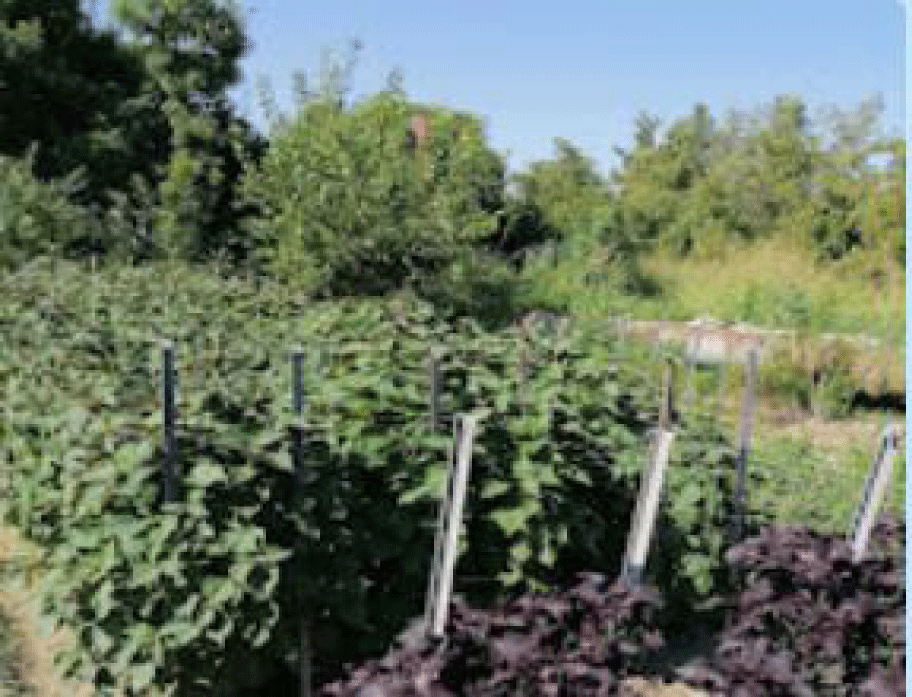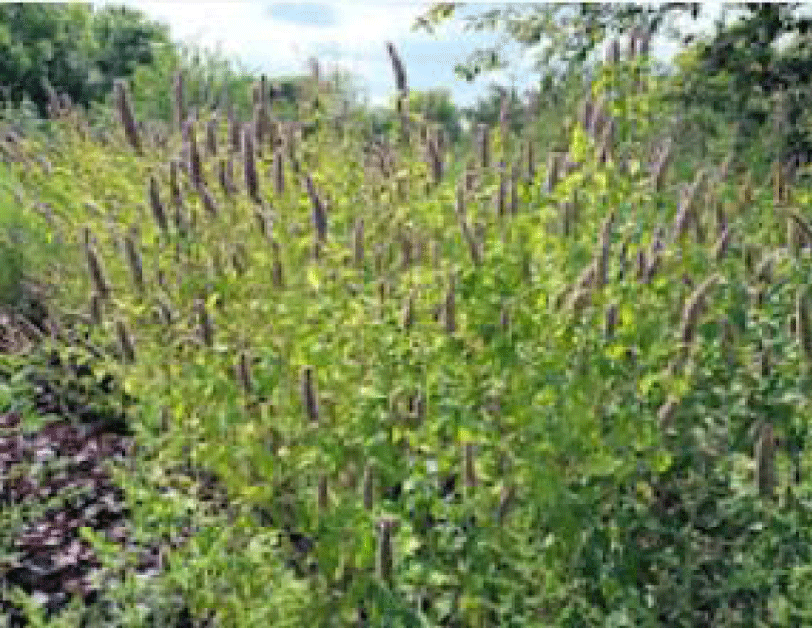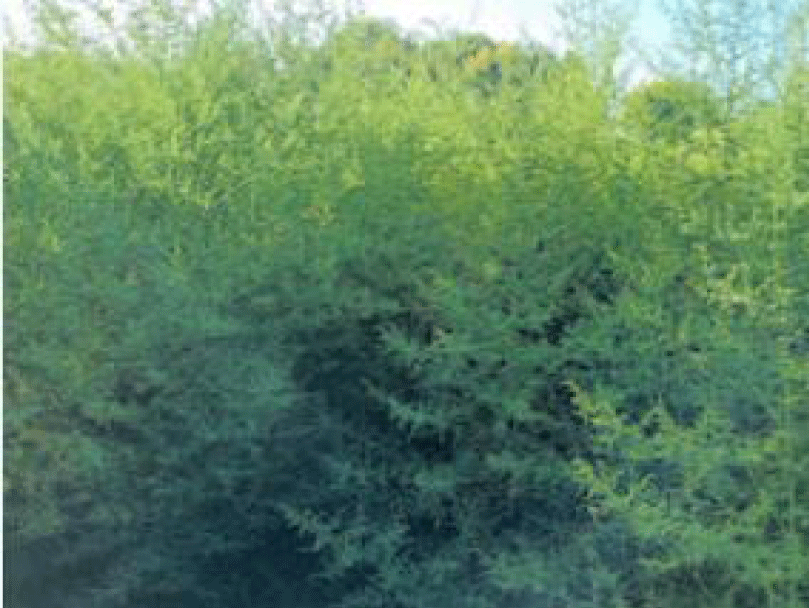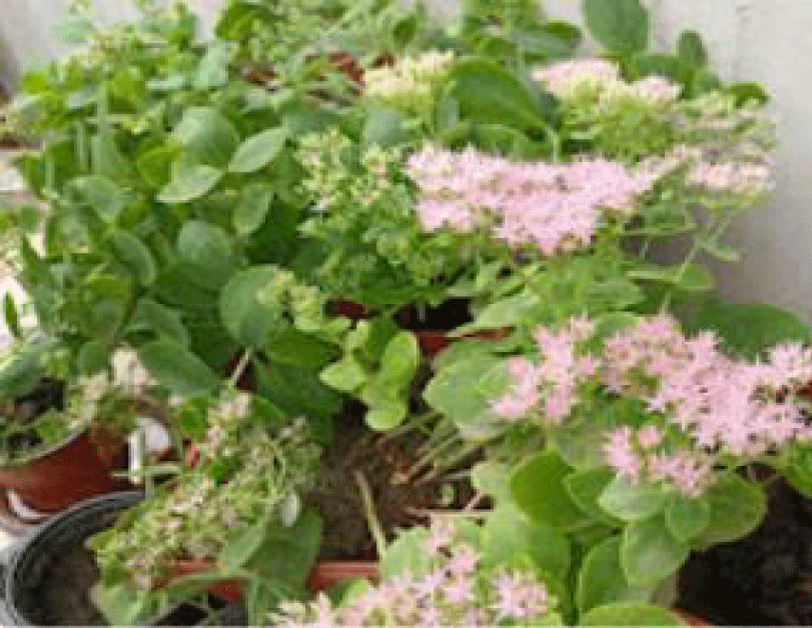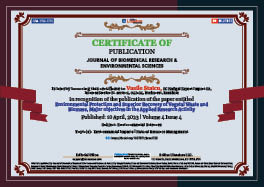Environmental Sciences . 2023 April 10;4(4):660-664. doi: 10.37871/jbres1723.
Environmental Protection and Superior Recovery of Vegetal Waste and Biomass, Major objectives in the Applied Research Activity
Vasile Staicu1,2*, Tomescu Justinian Andrei1,2 and Călinescu Ioan1
2Faculty of Chemical Engineering and Biotechnologies, Department Bioresources and Polymer Sciences, 1-7 Gh.Polizu St., 011061, Bucharest, UPB, România
- Vegetable waste
- Compost
- Medicinal plant
- >Natural repellent
- >Ecological education JEL classification
- >Q56, Q57 (I30)
Abstract
Vegetable biomass consumes a small part of the solar energy, about 1%, but enough to cover the energy needs of mankind and maintain the life of the entire planet [1]. Vegetable biomass is generators of minerals, chemical compounds, materials and fibres for industry and animal husbandry feed. The enormous interest in the superior recovery of biomass and vegetable waste has led to the additional research within the Research and Development Department at Hofigal SA, which I am a member of, in 2022 for:
- Making soils and substrates, from vegetable waste, for the growth of fungi.
- Industrial reuse of waste from industrial production activity.
- Obtain liquid, natural fertilizers and solid compost (humus) by recovering vegetable waste resulting from industrial activity and vegetable biomass resulting from crop maintenance.
- Create new sources of raw materials by acclimatizing new plants.
- Create new aqueous and hydroalcoholic plant extracts from spontaneous flora to protect agricultural crops against pests without using synthetic chemicals and other research activities.
The major objective of this research is to reduce the amount of waste and plant biomass resulting at Hofigal, as well as to create new resources of plant raw materials, leading to new products and food supplements for health care. For this purpose, we aimed to reduce the amount of vegetable waste, from industrial activity, from 30 tons to one ton/year. We also aimed to obtain 5 tons of plant protection solutions and 20 tons of liquid organic fertilizer from the aerobic fermentation of compost on concrete platforms. This liquid fertilizer will be used for fertilizing the plants with the irrigation/watering of the plants, because it is applied diluted.
We managed to acclimatize, in industrial cultures, in a 1-year cycle of culture, five new plants, three from the local spontaneous flora (wormwood, black wormwood and orpine-Sedum telephium) and two from the specific flora of China and Japan (lophantus and perilla). The achievements of the Hofigal Research and Development Department were validated by the Hofigal Scientific Council and proposed in the production plan for the year 2023-2024.
Introduction
The concept of ecological education and environmental protection adopted by the Faculty of Applied Chemistry and Biotechnologies of the POLITEHNICA University from Bucharest and the Department of Bioresources and Polymer Science proposes that, through research strategies, students and Ph.D students are put in a position to observe, analyze, investigate, environmental phenomena and processes, practicing intellectual work skills, simultaneously with the formation of responsible behavior, also in the relationship with the surrounding environment.
The energy, food and raw materials crisis has led to new approaches regarding the reintegration into the economic circuit of secondary resources-vegetal biomass and the superior recovery of vegetal waste. They can be generating minerals, chemical compounds, and materials for the industry. They can generate growth and plant protection stimulants based on natural products, antifungal, antibacterial products and develop new dyes of natural origin for the industry [2].
Through a collaboration protocol, for the period 2022-2023, concluded between the Faculty of Chemical Engineering and Biotechnology and Hofigal SA, an organizational framework for scientific collaboration between the two partners was established to reduce the amount of vegetable waste from industrial production activity and to create new products, which would capitalize plant biomass, offering the industry new raw materials and new solutions regarding the reintegration into the economic circuit of secondary resources-biomass and plant waste, reducing energy costs and raw material expenses. Thus, we shall contribute to solving the energy and raw materials crisis faced by countries all over the world and especially countries dependent on energy and gas imports. This collaboration protocol is intended for industrial activities and the maintenance of crops in the Hofigal heritage, within the Hofigal agricultural farms, which total 40 hectares of agricultural crops and two industrial production sections. This collaboration will be mainly carried out for the following activities:
- The analysis of the chemical composition and characterization of the waste from one's own activity and the capitalization of this vegetable waste.
- Creating new cosmetics, perfumes, floral waters and volatile oils from plants.
- The creation of new natural dyes used in dyeing textile fibres.
- Obtaining vegetable tannins and insecticides of plant origin.
- Production of biogas and biocompost through the process of metanogenesis of vegetal biomass.
- Transformation of harmful plants, allergenic, into technical plants, in order to eliminate dangers to human health (allergies).
Methods
For the industrial and agricultural specific of the Hofigal organization, the following research and industrial production activities are required in 2022-2023:
The characterization of the waste generated by its own activity is mandatory and occurs in order to determine the possibilities of recovering this waste, through:
- The industrial reuse of those containing bioactive compounds or
- The directing of this waste towards the production of natural fertilizers (compost).
- Another way of recovery is the creation from vegetable waste of soils or substrates for the growth of fungi or other plants.
- Production of natural growth stimulants and natural plant protection agents.
- Acclimatization of new plant species, in order to diversify the supply of food and raw materials useful to man and industry.
- Acclimatization in controlled cultures of invasive or harmful plant species, with a view to their transformation into technical, medicinal or spice plants.
- The acclimatization of some ornamental plants for the pharmaceutical exploitation of their therapeutic properties.
Through research activity aimed to carry out complex experiments and determinations regarding the analysis and characterization of vegetal waste and the superior recovery of vegetal biomass, resulted especially from the industry (processing industry of medicinal plants), following the following production activities:
- Maintenance of crops.
- Harvesting parts of plants, the other part being considered as waste.
- Activities in the production departments of plant extracts.
- Activities on seed-producing farms, for which mature plants become vegetable waste.
Results and Discussion
Following the research activities carried out within the doctoral school, the activity submitted to the practical training partner within the SMART PED project, with a view to the capitalization of plant biomass and plant waste, the following research activities were carried out, at the Hofigal headquarters, with the help of colleagues, of the practical training guide and the management of the company:
Soils and substrates for the growth of fungi
From the analysis of the following vegetable wastes: willow bark waste, passionflower waste, momordica waste, liquorice waste, mint waste, scrap metalsmith waste and Echinacea waste, by removing soluble lignin, followed by enzymatic hydrolysis of the substrate, high values for reducing sugars were determined for willow bark waste and liquorice waste [3]. These wastes can be used with priority to obtain compost, substrate for fungus-controlled crops or as solid vegetable fertilizer for newly established crops, due to the rich content of nutrients.
Industrial reuse of waste
From the analysis of the active compound from licorice waste (glycyrrhizic acid), it was found that, through industrial extraction, the extraction yield of the active principle is 82% [3]. This licorice waste contains 18% active substance and the industrial extraction can be resumed, through a new extraction, by adding a fresh solvent, after which the fractions obtained will be brought together for concentration. The waste resulting from the distillation process to obtain volatile oils share the same situation. The industrial process of hydro-distillation to obtain volatile compounds is a mild thermal process and after extraction the substrate can be used for a new boiling, in order to exhaust the plant. The new extract can be used by trapping it on seed meal (waste) or berry meal (waste), creating a new product.
Obtain compost
Vegetable waste, produced as a result of industrial extraction processes, can be used to obtain organically certified fertilizer for agricultural crops. This waste is processed through an aerobic fermentation process on a concrete platform. This process leads to the formation of liquid compost which is used in diluted form as an organic fertilizer for the soil.
The compost contains all the minerals originally in the plant composition, without having to apply additional expensive fertilizers. The obtained liquid fertilizer can be applied, diluted, with the irrigation of crops. The final humus (solid compost) obtained is, in turn, used as a vegetable fertilizer with the preparation of the soil for new crops, in the spring, by embedding it in the soil.
Acclimatization of new plants
New plants from Chinese and Japanese folk medicine have been acclimatized in order to diversify the plant resources for food and medicinal plants. For this purpose, Perilla frutescens and Lophantus anisatus were acclimatized, in order to obtain new pharmaceutical products with these raw materials. Perilla (Figure 1) is known as one of the best anti-allergic plants in the world, and lophantus (Figure 2) is recommended for respiratory ailments, due to the high content of volatile oil and in the form of tea as a refreshing and calming herb.
Acclimatization of various species from the spontaneous flora
Wormwood (Figure 3) or sweet wormwood (Artemisia annua) and mugwort (Artemisia vulgaris) were moved to controlled crops. The proposed goal is to use wormwood for medical purposes, due to its many therapeutic properties, and black wormwood as a spice. Wormwood is known for the successful treatment of malaria, which has become resistant to classical treatments, and for its moderate antitumor activity, especially due to the artemisinin (compound with antiviral activity) in its composition. The researcher YOU YOU TO, from China, won the Nobel Prize in 2015 for the discovery of artemisinin, in 1978-1983.
Artemisinin is a sesquiterpene lactone endoperoxide, its formula is C15H22O5, which, through the peroxide ring contained in its structure, develops a sufficiently large amount of free oxygen atoms, hyperactive, which succeed in destroying the unicellular protozoan parasite, Plasmodium falciparum, which causes malaria in humans. The parasite is transmitted by the bite of a female Anopheles mosquito and causes the most dangerous form of the disease, malaria falciparum [4].
The bioactive compound, artemisinin, also gives very good results in antitumor treatment, by taking it together with iron supplements.
It was a first, after a long time, to award this prize to a scientist, for the discovery of new plant compounds with healing properties, the tradition showing that this prize was awarded to researchers in the pharmaceutical industry, for the synthetic drugs discovered.
Acclimatization of various ornamental plants
The ornamental plant orpine (Figure 4) (Sedum telephium) was moved into the industrial crop category for the creation of an industrial plantation under controlled conditions. A tincture with antitumor properties is made from the root of the plant. The propagation of the plant is mainly done by cuttings, and to create a plantation, a large amount of cuttings and an intense planting activity are required.
Create natural repellents
In order to protect the plants from the established crops against pests, we produced and tested treatment solutions against the white fly, aphids and other harmful insects, by macerating the common wormwood (Artemisia absinthium) and Tanacetum vulgare plant (tansy), in large volumes of water, for 3-7 days in sunlight. Spraying is done 2 times a week or as often as needed. These spray solutions have a repellent effect, repel insects without killing them and are harmless to bees and butterflies [5].
Conclusion
Through the research activities, carried out within the Research and Development Department of Hofigal, with the support of the Faculty of Chemical Engineering and Biotechnology, we have carried out the above research activities, on the capitalization of biomass and vegetable waste, major objectives in applied research.
In the future, new activities and additional applied research will be carried out, to increase the number of acclimatized plants in industrial cultures and to find new ways of capitalizing biomass and vegetable waste, in order to reduce energy costs and create new raw materials and phyto-therapeutic products.
Plant biomass and plant waste can generate minerals, chemical compounds, materials and fibres for the industry, solid fuels for small households, feed for livestock. Therefore, the development of the biorefining concept is currently being discussed, in order to exploit plant biomass, with maximum yield, with the aim of creating new products with added value. Biorefining involves the development of technological processes for the fractionation of biomass into useful bio-compounds such as: hemicellulose, cellulose, lignin, which can replace those of petrochemical origin [6]. This will be the future concern for all researchers at Hofigal SA.
Acknowledgment
These activities required the financial and material support of the practical training partner, SC. Hofigal Export-Import SRL, through financial support within the practical training program at the practical training partner, as well as support and guidance from the doctoral supervisor and the doctoral school. In this way we thank them and hope for new collaborations in the future.
The authors are grateful for the financial support received, in the form of scholarships, through the Human Capital Operational Program, Priority Axis 6- Education and skills, Project: Training of doctoral students and postdoctoral researchers in order to acquire applied research skills - SMART, MySMIS code: 153734.
The authors acknowledge the financial support received from the Competitiveness Operational Programme 2014-2020, Action 1.1.4: Attracting high-level personnel from abroad in order to enhance the RD capacity, ID project P_37_471,MY SMIS 105145, Ultrasonic/Microwave Nonconventional Techniques as New Tools for Nonchemical and Chemical Processes, financed by contract 47/5 September 2016.
Conflicts of Interest
The authors declare no conflict of interest.
References
- Mohan GH, Avram A. Valorificarea resurselor vegetale în gospodării și în industrie. București T, editor. 1989.
- Universul Ingineresc, nr.17/2014. Biomasa vegetală, ca sursă de energie și produse chimice.
- Staicu V, Luntraru C, Calinescu I, Chisega-Negrila CG, Vinatoru M, Neagu M, Gavrila AI, Popa A. Ultrasonic or microwave cascade treatment of medicinal plant waste. Sustenability. 2021;13:12849. doi: 10.3390/su132212849.
- CDC-DPDx. Laboratory identification of parasites of public health concern, cdc.gov.
- AgroMentor.ro-Musculița albă de seră-combatere convențională și BIO.
- Universul Ingineresc, nr.17/2014. Biomasa vegetală, ca sursă de energie și produse chimice (AGIR-Asociația Generală a Inginerilor din România. 2014.
Content Alerts
SignUp to our
Content alerts.
 This work is licensed under a Creative Commons Attribution 4.0 International License.
This work is licensed under a Creative Commons Attribution 4.0 International License.





